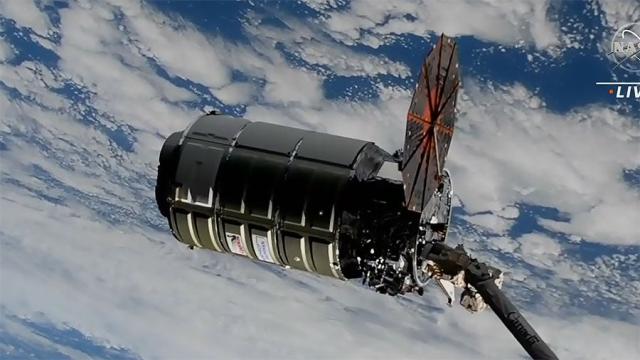The S.S. Sally Ride has safely docked at the International Space Station following a nail-biting journey in which one of its two solar arrays failed to deploy.
Northrop Grumman’s expendable freighter launched on Monday, November 7, carrying 3,719 kg of cargo to the ISS. On its way to the orbiting space station, however, the Cygnus capsule failed to deploy one of its two solar arrays, which collects power for its trip through space. “Northrop Grumman is gathering data on the second array deployment and is working closely with NASA,” the space agency wrote in a blog post on Monday.
Despite having only one fully unfurled solar array, the Cygnus spacecraft safely arrived at the ISS on Wednesday at 5:20 a.m. ET, according to a NASA blog post. As the cargo capsule approached the station, NASA astronaut Nicole Mann used the Canadarm2 robotic arm to grab the vehicle and manoeuvre it towards the station’s docking port. This is standard procedure for capturing Cygnus and not the result of the solar panel anomaly.

The 16.76 m-long (17-metre) Canadian arm features a “hand” that astronauts use to grab onto objects and even the ISS itself. After Mann commanded the robotic arm from inside the ISS, ground controllers took over to guide the capsule and dock it at the station’s Unity module, NASA wrote.
A reason for the malfunction has not yet been disclosed. “To remain focused on the spacecraft’s arrival at the station, Northrop Grumman and NASA made the determination not to deploy the second solar array after initial attempts to deploy it were unsuccessful,” the space agency said.
This is Northrop Grumman’s 18th resupply mission to the ISS as part of its Commercial Resupply Services contract with NASA, in which it delivers crew supplies, equipment, and science experiments to the orbiting station. The NG-18 Cygnus spacecraft was named after Sally Ride, the first U.S. woman to reach space, a feat she accomplished in 1983.
The cargo capsule delivered a diverse payload that includes a 3D printer for generating human tissues, an experiment on growing plants in space, and the first satellite developed by Uganda and Zimbabwe. The freighter will stay attached to the ISS until its fiery disposal in the Earth’s atmosphere in January.
More: Webb Telescope’s Mid-Infrared Camera Is Fully Back in Action After Worrisome Glitch
